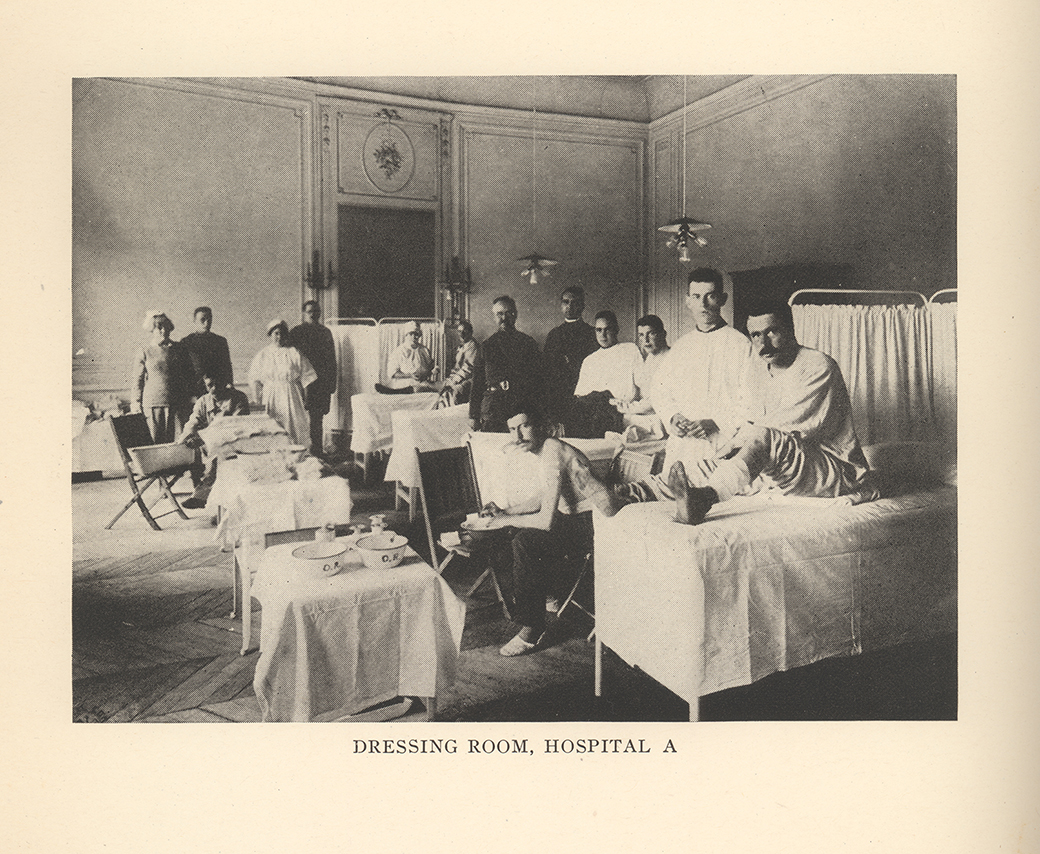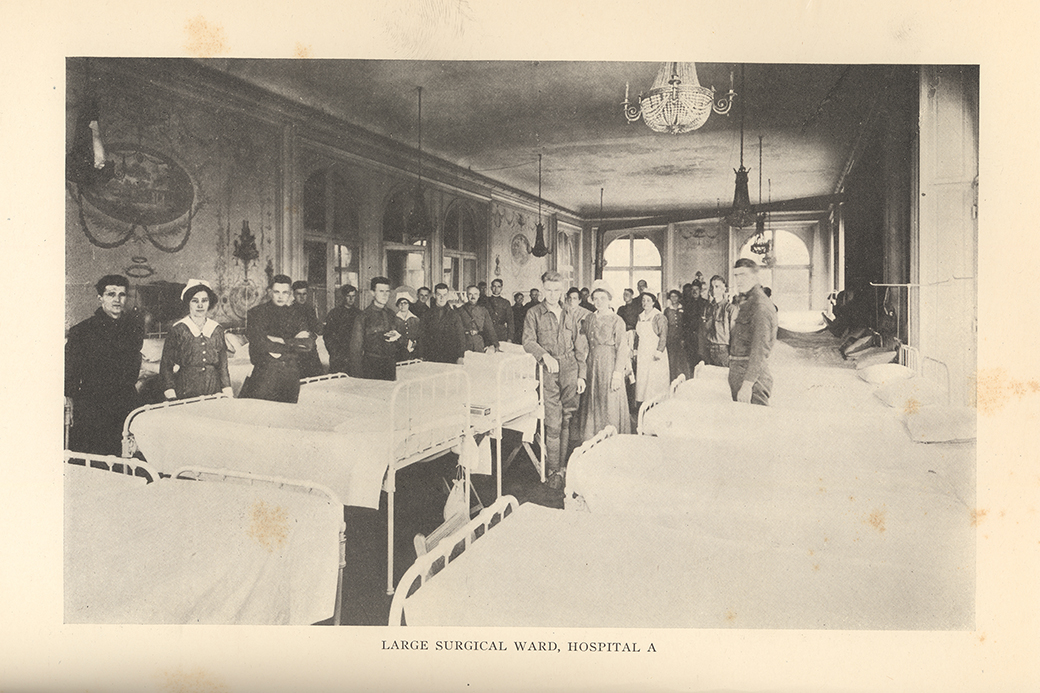Day 9 - Jun 10, Sat - Contrexéville
Rode 1.08 miles today
We started out day with breakfast at Hotel Cosmos, and afterward, we went to the reception to meet M. Gilbert Salvini, the president of a local history organization whom I had contacted prior to our departure to ask if we could arrange to talk with someone knowledgeable about the town's history in the years of La Grande Guerre. M. Salvini had responded, and I had suggested a meeting time of 9 am. But I had a brain lapse, forgot to double-check my message, and remembered the appointed time as 10 am. By the time we got to the reception, M. Salvini had been there and gone. I felt bad. What clods he must think we are!
We made several efforts to remedy the situation, starting first by asking at the reception desk. They told us that M. Salvini had been there and they had tried to find us, but we were at breakfast. (We later thought it was perhaps reassuring that none of the wait staff in the breakfast room could identify us as the only two Americans in the room, but nevertheless, the message did not get to us until M. Salvini had left.) He left his phone number and the young woman at the reception, Hülya, called and left him a voice mail message explaining what had happened. We also left Steve's cell phone number and then later also sent an email to apologize and thank him. We never did end up meeting with him, and it was probably just as well as I am sure he was busy, and I felt very bad about making the mistake to cause the whole misunderstanding.
It turned out okay, though, because the staff at the front desk provided us with a copy of the hotel history (it was actually a publication from M. Salvini's local history organization.) We took lots of photos of rooms around Hotel Cosmos, comparing the old photos I have from the unit history of Base Hospital 32 with what we were seeing. We identified three or four places in the hotel which are in the old photos -- the main surgery is the "Bridge Salon," the room where patients' wound were dressed is the "Tele-Salon" or TV room, and the large surgical ward is the present-day main dining room of the hotel restaurant.

.jpg)
The room used for dressing wounds in 1918 in Hotel Cosmopolitan is the Tele-Salon in today's Hotel Cosmos

.jpg)
The main surgery of Hospital A (Hotel Cosmopolitan) of Base Hospital 32 is the Salon de Bridge in Hotel Cosmos

.jpg)
The large surgical ward of 1918 is the hotel restaurant today

.jpg)
This area on the first floor is the hotel bar today
The art in the hotel is also interesting. There are lots of whimsical paintings with cats and horses.
.jpg)
Art in the Hotel Cosmos
After we finished photographs inside the hotel, we went and got our bicycles and rode to the center of town where I photographed other hotels which were used by Base Hospital 31 and BH 32. Some of the hotels leased by the AEF are gone now, and only a vacant lot or parking lot sits on the site today. Some are looking quite rundown and will be gone soon. The saddest for me to see was what was once the Hotel Souveraine. It was so beautiful 17 years ago when we first saw it. I've read that it was originally the villa of the Duchess Marie of Mecklenburg-Schwerin (later Grand Duchess Maria Pavlovna of Russia, aunt to Czar Nicholas.) She was the last of the Romanovs to escape from revolutionary Russia and died in exile and is interred in Contrexéville.
We went to the Catholic church and located the town's memorial to the war dead of WWI and WWII. We looked in the town's cemetery on the hill behind the church for any graves of American soldiers. Several were buried here, but apparently all -- with the exception perhaps of one unknown solider -- were reinterred elsewhere. We found the section of the village cemetery which holds the French military graves, and not far from that (about six or seven rows further up the hill) was a stone that read "A solider of the Great War... known unto God." As we left the cemetery, I could hear the voices of people singing in the church. We stood outside the church and listened a while as we contemplated the cemetery on the hill.
.jpg)
An unknown soldier in the cemetery at Contrexéville
It was now nearly 3 pm, and we tried to get some lunch. The waiter at the corner bar, Bar de la Paix, gave a discouraging look when we asked about "menu," but somehow they scrounged up what was left of one of the day's specials -- paella -- and brought two plates. He warmed up as we placed an order for beers -- a "grande" beer for Steve and a "petit" beer for me. Later, I tried to ask him about La Grande Guerre because his restaurant sits in one of the buildings which was a hotel in 1918 and leased to the AEF. He understood my question but said the military hospital was in Vittel. I had my iPad with me and was getting a free wi-fi signal so pulled up the photos of Hotel Martin Felix (as his establishment was called in 1918.) He recognized it. I pointed to the words "Hospital No. 7, Base Hospital 31," and his eyes grew large. Yes! That is his restaurant. I showed him a photo of Aunt Agnes and explained who she was. He understood. As Steve and I departed and thanked him, he wished us well and expressed pleasure at our meeting.
We stopped at the Tourist Office and bought a T-shirt with " Vittel - 2017 Tour de France" on the shirt. (The race will come through here on July 4 and 5th this year.) The purchase qualified us for a lottery to win a car or some other prize, so we'll just wait and see how that works out (I hope we don't win a Citröen Berlingo!) I asked the women in the tourist office about the history of La Grande Guerre and showed them some photos from the BH 32 unit history that I had not been able to identify. One photo in particular eluded me -- the one with a caption that simply says "Lallemont's" -- did they know this place? The younger woman asked her older colleague, and she did not know, but she searched the internet and began reading a caption in English. After just a few words, I realized that she was reading from my own website about Contrexéville (http://mollydaniel.net/contrexeville.) So we didn't get any new information there, but I have a cool T-shirt now.
We went back to our hotel room to shower before the 5 o'clock appointment for massages at the hotel spa. (When we entered the spa, we saw two pages of information about Hotel Cosmopolitan in the Great War, printed from my website, lying on a table in the reception area.)
The massage therapists managed with pantomime and French to give us instructions, and we each had a very soothing massage. Their touch was actually a little too light for out tastes -- particularly after 8 days of bicycling -- but it was still a nice experience.
We went back to our room to shower. Steve took a nap while I went out to take more photos. While trying to get the correct angles on the room in the foyer of the Casino, I could hear the concierge speaking to me. I walked over and explained that I do not speak French but showed him the photos I had from the Casino in La Grande Guerre. He was astounded and called the boss. The boss was intrigued and gave me his business card and asked if I could send him the photos by email.

.jpg)
In 1918, the Casino provided an area for surgery and was later used as a patient ward
Since they seemed pleased, I dared to ask if I might snap a photo of the Casino's theater (a spectacular piece of architecture.) They were getting reading for a performance, but another important looking man took me in the door and said something in French (he seemed a bit furtive about allowing me to photograph, so I took his words to be something to the effect of "we don't usually allow photographs, but just take one real quick." At least that is what I did, thanked him and said au revoir.)

.jpg)
The Casino theater, then and today
I strolled through the park and took some photos with the evening sun making the light dramatic and a little tricky. I found the old Russian Church and the other "English church" (Protestant) beside it. Between them is a grassy space and small garden -- a sign said it is "the Russian garden." I think this is where the American Red Cross Hut was during Agnes's time in Contrexéville. This is where they hosted social events and provided a sort of commissary for the military personnel. It was a temporary building which was probably torn down shortly after the war. It would have looked out of place between the two little churches anyway.
.jpg)
The Russian Orthodox Church in Contrexéville and the Anglican Church (at left) - the American Red Cross Hut was located between the two churches in 1918.
The Russian church holds the remains of the Grand Duchess and her son, Grand Duc Boris, as well as some other members of the Romanov family (the lineage is actually no longer officially recognized, but they know who they are.)
Once I got back to the Hotel Cosmos, Steve and I had some wine and light appetizers for dinner in the garden. We studied our maps and plotted our day with the car tomorrow. There is lots we would like to see near Château-Thierry on the way back to Meaux, so we are aiming to get away around 9 am.
.jpg)
The staircase in Hotel Cosmos - it is certain that Aunt Agnes climbed these same steps. The patients treated in Hospital A (Hotel Cosmos) had to be carried on stretchers up these steps. There was no elevator which could accommodate them.
Lessons learned:
- Check and then double-check your schedule.
- If you put it on a website, the whole world will think it's true.
- Old photographs can open a lot of interesting conversations.
Continued, Day 10